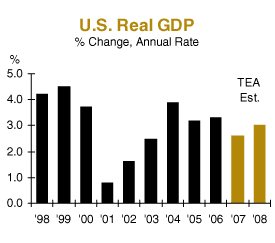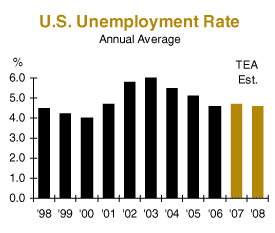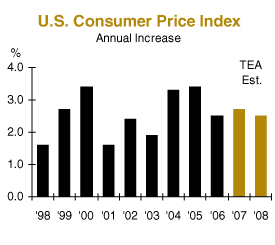|
June 13, 2007
Summertime View
Written by Jeff Thredgold, CSP, President, Thredgold Economic Associates
The U.S. Economy
…picking up
The first quarter’s pathetic 0.6% real (inflation adjusted) annual growth pace should be followed by a 2.2%-3.2% growth rate over the next 12 months, more in line with the 3.2% real growth pace of 2005 and 2006. Both the broad services sector and the manufacturing sector have shown recent signs of improvement. Financial market players are less concerned about the chance of recession…and more concerned about solid economic growth aggravating inflation. It’s always somethin’!
The Federal Budget
…revenues surge
A budget deficit of $150 billion or less (the smallest in six years) seems on tap for fiscal year 2007, which ends next September 30. Surpluses at the state and local level offset the nation’s shortfall. Powerful gains in individual and corporate tax revenue, tied to income and investment tax cuts of recent years, are today’s reality. When you cut tax rates, you typically generate more tax revenue. Of concern? Budget challenges become more daunting in coming years.
 Employment Employment
…labor shortage
The nation’s unemployment rate averaged 4.6% over the past 18 months, below the averages of the ’70s, the ’80s, and the ’90s. The issue of tighter labor availability—especially for skilled workers—will challenge businesses of all shapes and sizes. Growth of the labor force in coming years? The slowest ever.
Inflation
…oil unknown
Most forecasters see 2007 consumer inflation near 2.5%-2.8%. By comparison, the Consumer Price Index rose 2.5% last year, 3.4% in 2005, and 3.3% in 2004. The direction of oil prices has a great deal to do with subsequent inflation pressures.
The Federal Reserve
…gone fishin’
The Federal Reserve has been on the monetary sidelines since June 2006, following 17 consecutive 0.25% hikes (to 5.25%) between June 2004 and June 2006 in the critical federal funds rate. Prior to that period, the federal funds rate was at a 46-year low of 1.00% for 12 months.
Most forecasters expect the Fed to remain on hold through the end of the year, with some expecting a small rate cut late in the year. Making it interesting? A vocal minority of economists still expect the Fed to tighten later in the year.
Long-Term Interest Rates
…global pressures
Thirty-year fixed-rate mortgages rose to the 6.50%-6.80% range in mid-June as signs of strong global economic growth raised inflation anxiety. However, don’t listen to those who might talk of 7.50% to 8.00% to 8.50% mortgages just around the corner. It won’t happen.
Home Prices
…realistic pricing
Surging home prices on both coasts and in the Southwest during 2002 to 2006 gave way to a buyers’ market more recently. The simple reason? The average American home rose 53.53% between March 31, 2002 and March 31, 2007. Florida?…up 102.12%. California?…up 98.80%. Nevada?…up 95.75%. Arizona?…up 93.76% (source: OFHEO).
Home owners and “investors” simply became too greedy, requiring the current painful downward adjustment in many markets. We expect greater home price strength in the nation’s interior as relative values (compared to the coasts) are attractive.
The Global Economy
…solid growth
Strong global economic growth continues, following impressive growth during the prior four years. Solid growth for 4-5 consecutive years is the first such occurrence since the early 1970s. Risks to ongoing solid growth include any major terrorist atrocities (especially on American soil), much higher oil prices, and a worsening of Middle East tensions.
Japan, the global community’s second largest economy, returned to modest economic growth during the past few years after a decade of economic stagnation. Stronger consumer spending at home and rising exports to China have benefited the Japanese economy.
Powerful Chinese economic growth and higher Chinese stock prices of recent years have led to further steps by political leaders to slow the economy down. Excessive growth has also led to serious environmental damage, with polluted air in major cities and poisoned rivers the norm.
Strong Indian economic growth also remains on track, although an infrastructure of two-lane national highways and antiquated airports, sewers, and water systems must be addressed. Most other economies in the Pacific Rim are performing reasonably well.
The European economy has improved, with real growth near 2.7%-3.0%, the best in six years. Germany and France still struggle with jobless rates nearly double those in the U.S. and Japan. Long-delayed labor reforms bode well for greater European competitiveness in coming years. The European Central Bank has raised its key short-term interest rate eight times since late 2005 to keep inflation under wraps. An additional hike or two could occur later this year.
By various measures, Russia has now surpassed Saudi Arabia as the world’s largest oil producer. Moves toward greater governmental control and lesser individual freedoms are worrisome to both the citizenry and Kremlin-watchers around the globe. President Putin still talks of stepping down in 2008…we’ll see.
Various South American countries struggle with high taxes and stifling regulatory burdens. Oil-rich Venezuela remains a political powder keg, with oil production now in decline.
Canadian economic growth has slowed, although the energy-rich Western provinces are booming. The nation’s most recent unemployment rate of 6.1% was a 33-year low. The Mexican economy is growing at a reasonable pace, with the immigration issue highly charged on both sides of the Rio Grande.
The Bottom Line?
U.S. economic performance is likely to return to a more solid pace, following sluggish first quarter growth. In addition, we expect: a declining budget deficit…tighter labor availability…modest inflation pressures…relative stability in both short- and long-term interest rates…soft coastal housing markets, with more solid interior performance…and an anxious but impressive global marketplace.
Email this article to a friend
|
|
Subscribe to the Tea Leaf
Like what you just read? Have Jeff Thredgold’s Tea Leaf emailed to you free each week. Subscribe today.
|
|
|

“Tea”ser
Keep your eyes wide open before marriage and half shut afterwards.
Send us a “Tea”ser of your own.

“Tea”stimonial
“We are still tabulating the evaluations, but so far your session has received a 4.6 rating on a 1-5 scale. From our audience, a rating like this is almost impossible.”
—Diane Spiegel, CMP, Manager of Conferences, California Credit Union League
More testimonials
Invite Jeff Thredgold to speak at your next conference, meeting, or client function
If you like the Tea Leaf, you’ll love Jeff Thredgold’s live presentations. Jeff takes your audience on a timely, engaging, and entertaining tour of the U.S. economy and financial markets. Debunking some of today’s most common economic myths, he offers a clear picture of how the American economy is really performing and what that means for the future of your finances.
|
